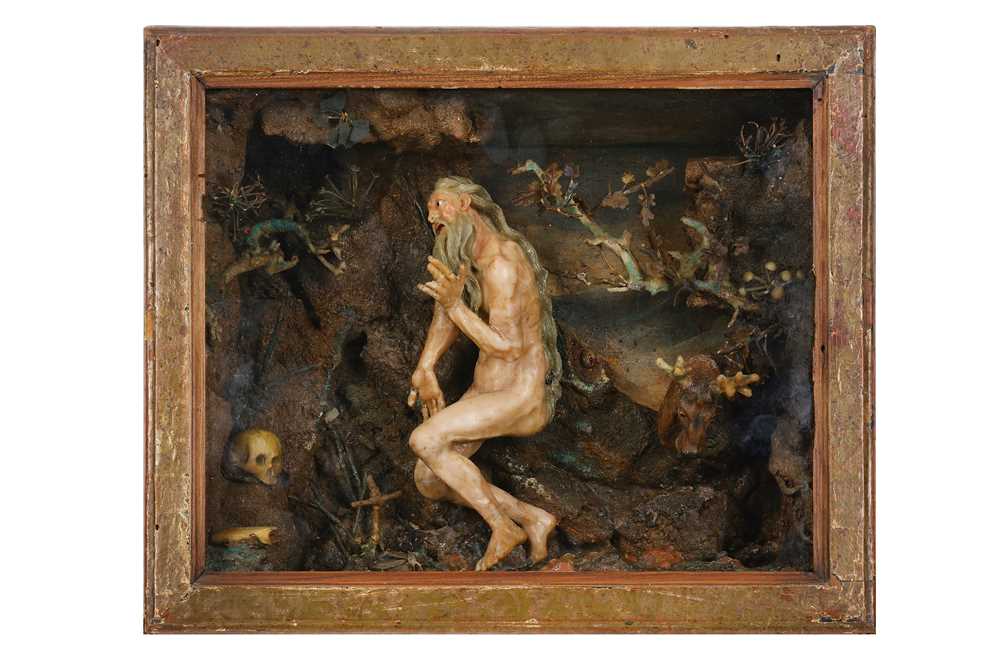21st Jan, 2020 10:00
From the Curious to the Extraordinary
ATTRIBUTED TO CATERINA DE JULIANIS (ITALIAN, 1670-1742): AN EARLY 18TH CENTURY WAX, SILK AND PAINT DEVOTIONAL DIORAMA DEPICTING ST JEROME IN THE WILDERNESS the nude male saint with long flowing hair and beard, a skull and cross at his feet and a stag appearing from the rocky surroundings, mounted in a painted wood and glazed frame, 27.5cm wide x 23cm high overall The art of modeling in polychrome wax rapidly translated to a scientific application during the late 17th and early 18th century. On account of its utilitarian function, the medium has largely been discounted as belonging to art historical discourse inasmuch as scientific history. However, the Baroque era initially professed the medium as an artful and esoteric curiosity. Evidence for this can be observed in the career of the most celebrated master of the genre, Gaetano Giulio Zumbo (1656-1701), a self-taught monk who excelled in the art, leading to the patronage of Cosimo III de’Medici in Florence, for whom he executed teatrini (little theaters) or dioramas depicting five stages of death and decomposition. The malleability of the medium provides the possibility of intricate detail on a small scale. These sculptural works in wax, set deep into their frames created a shadowbox from which sculpture could emerge. Their small scale served only to enhance their intimacy, commanding the viewers' attention and sparking imagination when one’s eyes set upon these little theaters. The present work, 23 x 27.5 cm, depicting a Penitent St. Jerome in the Wilderness, may be attributed to Caterina de Julianis on stylistic grounds. There is an immediate relationship observed between the character of Jerome and Father Time as featured in Caterina’s Time and Death (Victoria & Albert Museum, Inv. A.3-1966). The physiognomy is alike and the expression of both protagonists is commensurate. However, finer details confirm her signature style. From a materials perspective, the polychrome of the flesh and hair use the same formulaic tones as observed on her signature works. The employ of glass eyes to capture expressive realism is alike as is the use of silk flowers and wax-modeled foliage sprouting from their environs with a painted backdrop on wood panel. Stylistically, the pursed brow, agitated eyes, agape mouth, featuring superbly modelled teeth, along with spiraling hair delineated by long striations are completely alike between the figure of Jerome and that of Father Time in an Allegory of Time at the Chiesa dell’Immacolata in Catanzaro. The emaciated figure of Jerome’s exposed back recalls also the anatomical character of the right-most attendant in her Adoration of the Shepherds also at Catanzaro. Likewise comparable is the figure of the bull within her Adoration and that of the deer in the diorama of Jerome, which would have hovered over the back of a prostrate lion, now lost. The characteristic animal hair, formed by striations in the wax which are lengthy and densely packed is relatable. Lastly, there is an apparent correlation between the book and skull in the Jerome and those featured similarly on her autograph Mary Magdalene in Adoration from 1717. Many of Caterina’s works are lost or have been destroyed over time,4 though some survivals are known, most notably those already discussed at the Church of the Immaculate in Catanzaro, Italy. These works were recently restored and exhibited to much praise and success. The V&A has also recently shed light on this art-form and Caterina’s work via their exhibit, 'Welcome to Hell', which showcased also the work of her celebrated mentor, Gateano Giulio Zumbo. Though Caterina operated under the auspices of Zumbo for about 15 years, she yet blossomed with her own distinctive appeal and approach to the art form. Of similar scale to the Jerome is also the Jerome in the Desert in Harvard University’s Museum (Inv. 1966.80). The diorama is alike in its simplicity, relying on a painted background with wax surrounds to build-up the scene. In 1820, Giovanni Battista Gennaro Grossi, published a brief biography of Caterina’s work, noting she had made herself famous for the formation of natural silk flowers, adding the scent of the species to which they belonged,6 7 indicative of her devotion and dedication to hyper-realism and a multi-sensory experience.
Sold for £2,200
Includes Buyer's Premium
Do you have an item similar to the item above? If so please click the link below to submit a free online valuation request through our website.
